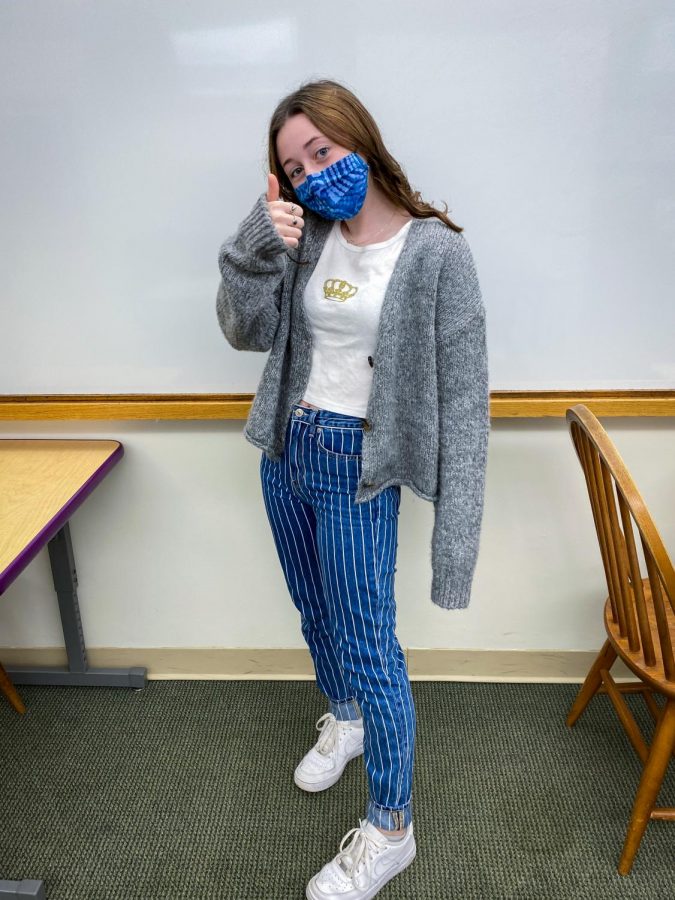Thrifting presents an ethical dilemma
Junior Annie Fabian sports an all-thrifted outfit, sporting clothes she purchased online or traded for.
November 4, 2020
The 2016 television show “GIRLBOSS” depicts the beginning of real-life entrepreneur Sophia Amoruso’s fashion empire Nasty Gal vintage, which began as only an eBay store. Amoruso’s counterpart in the show got her start after hustling a thrift store owner into selling her a jacket for only $9 and some free business advice: “this is an original, 1970s, east/west cask-in motorcycle jacket in perfect condition; know what your [stuff] is worth.” She resold the jacket for $615.
Thrifted clothing is in high demand. According to ThredUp’s Resale Report, consumers are more open to thrift shopping than ever before, with Generation Z adopting second-hand fashion faster than any other age group.
In 2020, thrifted clothes are trendy. The Wall Street Journal article titled “The Rise of Hand-Me-Down Inc”, by Suzanne Kapner, said “Bargain hunting, environmental concerns and the sharing economy have erased the stigma of used goods at the same time technology has made thrift shopping more accessible, reliable and cool. Even Kim Kardashian West wears vintage designer duds.”
Shopping at thrift stores, however, carries more ethical implications than it may seem. If people from a wealthier demographic shop at cheap, but well-known thrift stores, like Goodwill or Salvation Army, store owners may raise their prices due to the higher demand. This market trend is called thrift store gentrification. According to a study by Spencer James at Pennsylvania State University in 2010, higher-income consumers see thrift shopping as a commodity, while lower-income consumers see it as a necessity.
I might think the $5 pair of jeans I found at the bottom of the bin will work great with my wardrobe, but someone else might feel relieved that they can afford warm clothes for winter. Would you purchase that interesting looking cardigan if you knew you were depriving someone of affordable clothing?
In 2010, Goodwill’s price estimates were presented as a flat rate, but in 2020, the valuation guide offered a range of costs, indicating that quality and style impacts prices, and thus profit. Many important clothing items, like coats, went from a price of $8 to a range of $7-$40.
Not all second-hand stores are cheap, like Amoruso’s Nasty Gal vintage, which serves a moderate price range. Many high-end thrift clothing stores sell rare vintage finds for triple-digit prices. Wealthier consumers shopping at high-price stores, like Cure in New York City, won’t actively harm low-income shoppers, because the demand for cheap thrifted clothes has stayed the same. Wealthier demographics have financial access to clothes across the market, but it is consumers’ responsibility to be cognizant of their impact.
As the trend has moved from retail to resale, the second-hand market has developed online. Young people have created small businesses on apps like Poshmark and Depop, which are almost exclusively dedicated to buying and selling clothes. This is another moral grey area: thrifted clothes, bought for cheap, are resold at a higher price for profit. Trendy reselling services could be actively harming low-income communities, which have a greater proportion of Black, Indigenous, people of color (BIPOC). However, some online stores resell high-quality clothes at marked down prices, making them more accessible to everyone.
It is more sustainable to purchase used clothes, than a new shirt from a fast fashion retailer. Individual choices that lead a more environmentally conscious lifestyle are great, but part of rejecting clothing overconsumption is being aware of our impact, environmentally or otherwise. Contributing to thrift store gentrification is either being ignorant or apathetic to our influence as wealthier customers.
Moreover, if the less wealthy market is driven away from thrift stores, they may have to rely on other sources of cheap clothing, like fast fashion, which wreaks environmental havoc, from the factory manufacturing process to the landfills and incinerators where short-lived trends and poorly made clothes end up.
It’s not bad to purchase second-hand clothing, in fact, it is one of the best choices an individual can make to reduce their carbon footprint. However, there are ways to thrift shop more ethically – consider the market your local thrift store serves, don’t buy up necessities, like children’s and plus-size clothing, and don’t create a small business out of reselling. As the nation has shifted to become more aware of systemic inequality, it is imperative to confront and take responsibility for our behaviors as consumers.
















